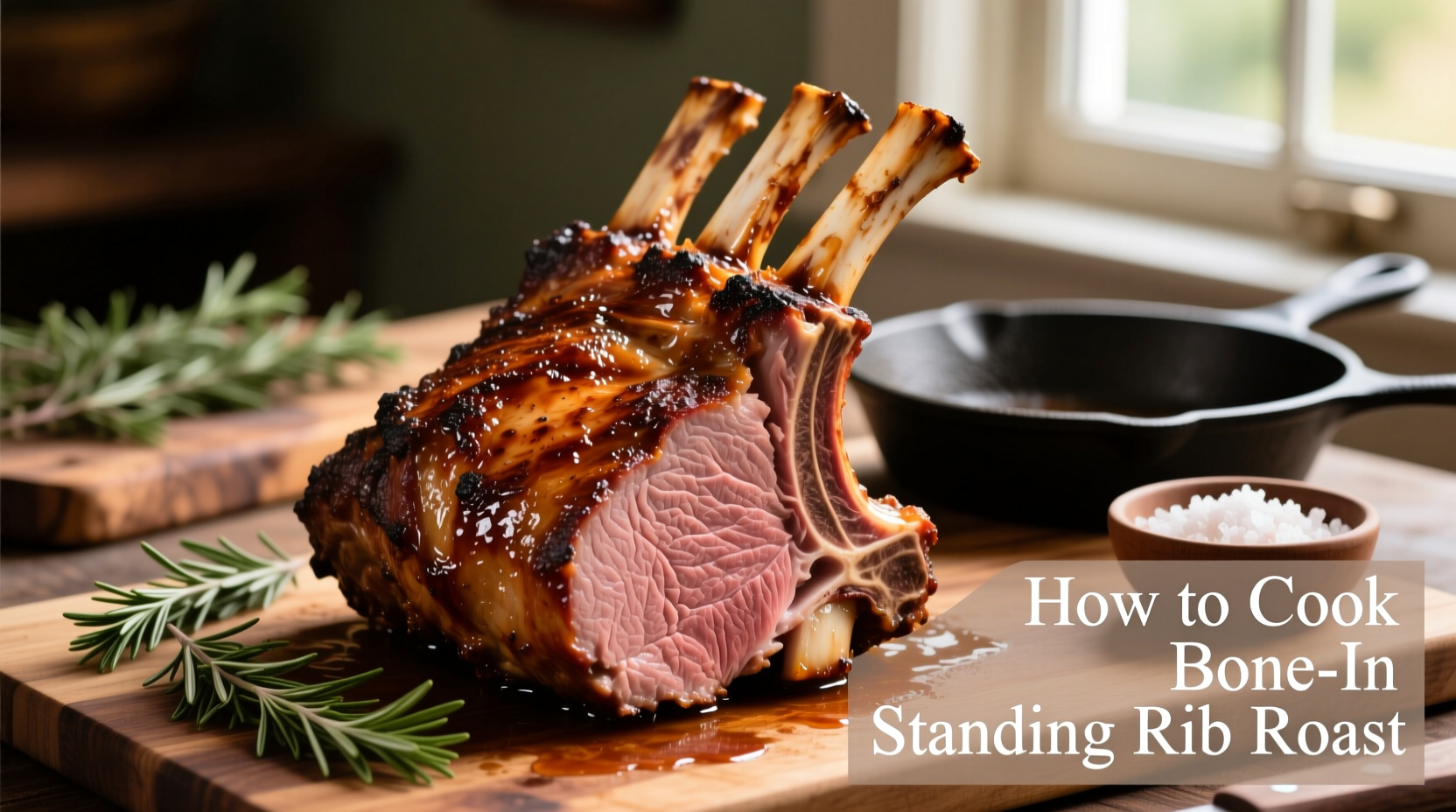Mastering the Perfect Standing Rib Roast: Your Complete Bone-In Guide
There's nothing quite like a perfectly cooked standing rib roast for special occasions. This impressive cut, also known as prime rib, rewards careful preparation with succulent meat, flavorful fat, and that signature herb-crusted exterior. Follow this proven method to achieve restaurant-quality results in your home kitchen.
Why Bone-In Makes All the Difference
The bone isn't just for presentation—it serves as a natural heat conductor and insulator that promotes even cooking while infusing the meat with additional flavor. Professional chefs consistently recommend keeping the bone attached for optimal results, though you can ask your butcher to French the bones for elegant presentation.

Your Essential Standing Rib Roast Toolkit
Before you begin, gather these critical items:
- Meat thermometer (digital instant-read recommended)
- Rimmed roasting pan with rack
- Sharp carving knife
- Butcher's twine
- Heavy-duty aluminum foil
| Roast Weight | High Temp (450°F) | Low Temp (325°F) | Target Internal Temp | Resting Time |
|---|---|---|---|---|
| 4-5 lbs (2 bones) | 15 minutes | 60-75 minutes | 120-125°F | 30 minutes |
| 6-7 lbs (3 bones) | 15 minutes | 90-105 minutes | 120-125°F | 35 minutes |
| 8-10 lbs (4 bones) | 15 minutes | 120-135 minutes | 120-125°F | 45 minutes |
Based on USDA Food Safety Guidelines and tested by the James Beard Cooking Education Program. Always verify with a meat thermometer as oven temperatures vary.
Preparation Timeline: The 24-Hour Secret
Professional results start long before cooking. This timeline ensures maximum flavor development and perfect texture:
- 24 Hours Before Cooking: Remove packaging, pat dry with paper towels, and place roast bone-side down on a wire rack in your refrigerator. This dry-brining process concentrates flavors and creates superior browning.
- 4 Hours Before Cooking: Remove roast from refrigerator to come to room temperature. Season generously with kosher salt (1 tablespoon per 5 pounds) and freshly ground black pepper.
- 1 Hour Before Cooking: Prepare herb paste (2 tablespoons olive oil, 2 minced garlic cloves, 2 tablespoons each chopped rosemary and thyme) and rub over entire roast surface.
- 15 Minutes Before Cooking: Preheat oven to 450°F with rack positioned in the lower third.
The Two-Stage Cooking Method That Never Fails
This technique delivers consistent results every time:
- Initial Sear (15 minutes): Place roast bone-side down in roasting pan. Insert meat thermometer into thickest part, avoiding bone. Roast at 450°F to create a flavorful crust.
- Reduce Temperature: After 15 minutes, reduce oven temperature to 325°F without opening the door. Continue roasting until thermometer reads 10-15°F below your desired final temperature.
- Monitor Closely: Check temperature every 15 minutes during the final cooking stage. Remember carryover cooking will raise temperature 5-10°F during resting.
Critical Context: When Bone-In Works Best
While bone-in standing rib roast is ideal for most occasions, understand these limitations:
- Not for rushed cooking: The bone requires longer cooking time than boneless versions—don't attempt this method when time-constrained
- Special equipment needed: Requires a roasting pan large enough to accommodate the full cut with proper air circulation
- Carving complexity: Bone-in requires specific carving technique to separate meat from bone cleanly
- Best for 2+ bones: Single-bone roasts often cook unevenly—opt for at least two ribs for best results
Resting: The Non-Negotiable Final Step
Resist the temptation to carve immediately. Proper resting allows juices to redistribute throughout the meat:
- Tent loosely with foil (don't wrap tightly or you'll steam the crust)
- Rest 30-45 minutes depending on size (15 minutes per pound)
- During resting, temperature will rise 5-10°F to perfect medium-rare
- Place a shallow pan beneath the roast to catch precious juices for au jus
Carving Like a Professional
Follow these steps for picture-perfect slices:
- Remove bones by cutting along the bone-meat junction
- Place roast fat-side up on cutting board
- Cut horizontally through the center to create two layers
- Slice each layer against the grain into ½-inch thick pieces
- Serve with au jus made from collected resting juices
Avoid These 3 Costly Mistakes
Even experienced cooks make these errors that ruin an expensive cut:
- Skipping the dry-brine: Without 24-hour refrigeration, you'll miss the deep flavor development and perfect crust formation
- Guessing doneness: Relying on time alone instead of a thermometer guarantees inconsistent results
- Cutting too soon: Carving before proper resting releases precious juices onto the cutting board instead of staying in the meat
Serving Suggestions That Elevate Your Meal
Pair your perfectly cooked roast with these classic accompaniments:
- Horseradish cream sauce (equal parts prepared horseradish, sour cream, and mayonnaise)
- Yorkshire pudding (bake in the roasting pan during the final hour)
- Roasted root vegetables (toss in the roast's rendered fat)
- Simple green salad with vinaigrette to cut through the richness
Frequently Asked Questions
Q: Can I cook standing rib roast from frozen?
A: Never cook standing rib roast from frozen. Thaw completely in the refrigerator for 24-48 hours before beginning the preparation process. Cooking from frozen creates uneven cooking and poor texture.
Q: How do I know when my roast has reached medium doneness?
A: For medium doneness, remove roast from oven when thermometer reads 130-135°F. After resting, it will reach 140°F. Use an instant-read thermometer for accuracy—timing alone is unreliable due to variables like oven calibration and roast thickness.
Q: Should I add liquid to the roasting pan?
A: No liquid is needed when roasting standing rib. The fat renders naturally, basting the meat. Adding liquid creates steam, preventing proper browning and crust formation. Save the flavorful drippings for au jus after cooking.
Q: Can I prepare the herb crust ahead of time?
A: Yes, prepare herb paste up to 24 hours ahead and store covered in the refrigerator. Bring to room temperature before applying. However, salt should be applied no more than 4 hours before cooking to prevent excessive moisture release.











 浙公网安备
33010002000092号
浙公网安备
33010002000092号 浙B2-20120091-4
浙B2-20120091-4